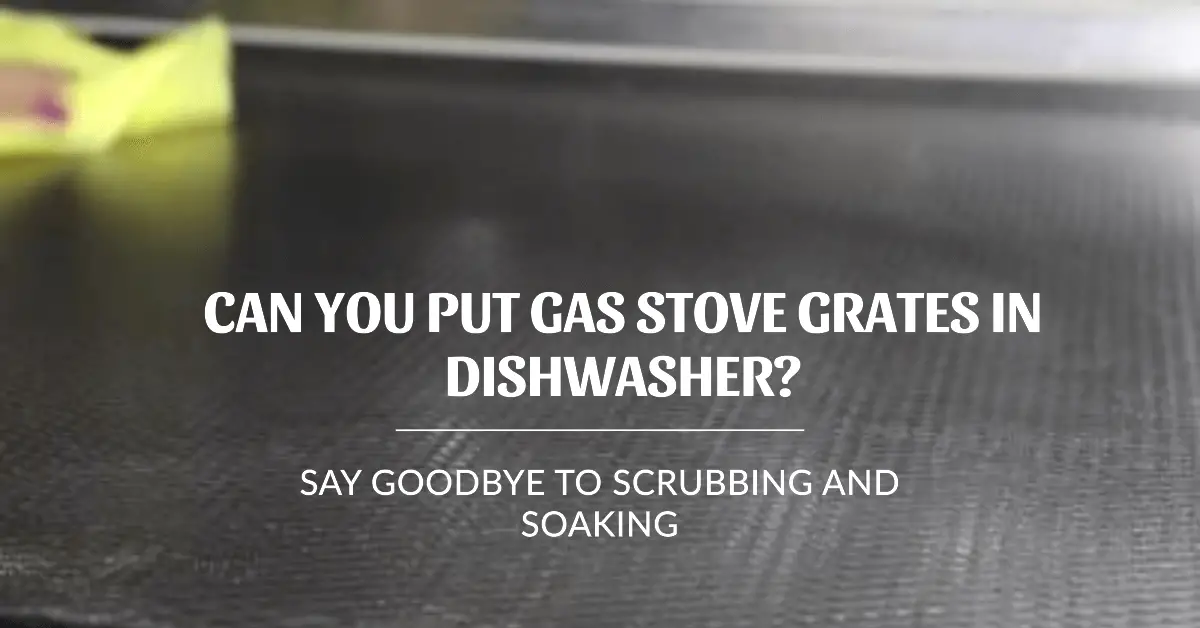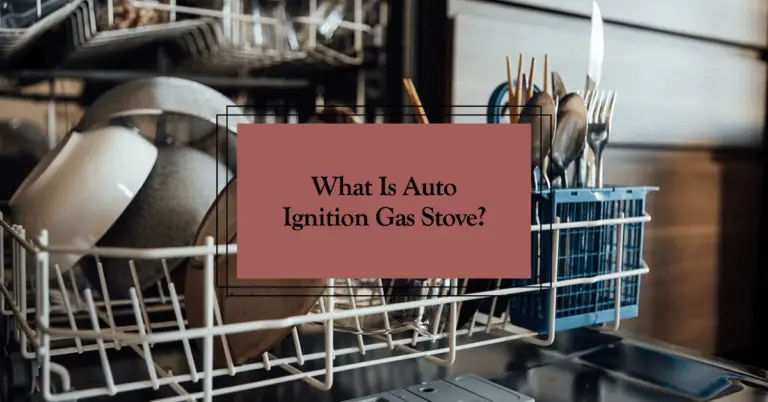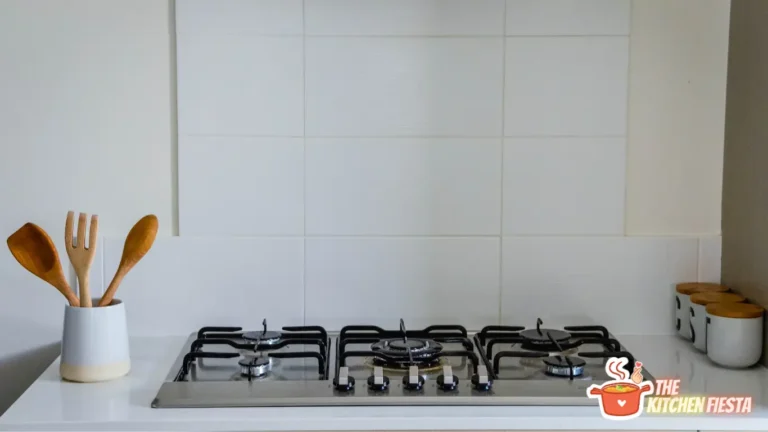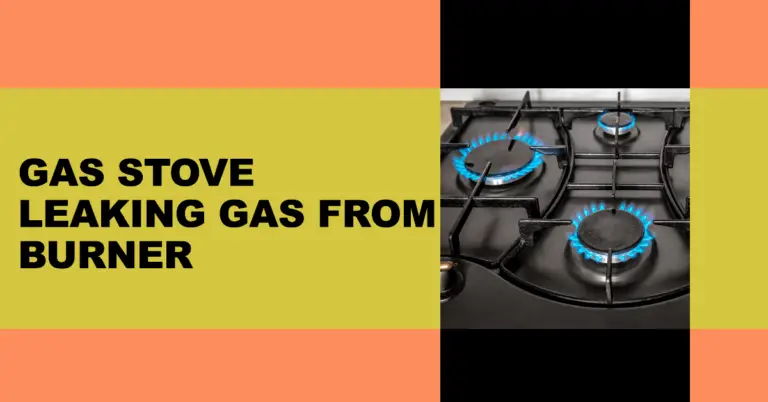Can You Put Gas Stove Grates in the Dishwasher?

Do your gas stove grates look grimy? Are you tempted to just pop them in the dishwasher to get them clean?
It’s a common question many home cooks and cleaners wonder about. After all, the dishwasher seems like an easy shortcut for cleaning gunky grates.
But should you really put gas stove grates in the dishwasher?
The short answer: It depends.
While the dishwasher may be a quick solution for cleaning the grates, it could also damage them over time.
In this detailed guide, we’ll cover:
- What materials stove grates are made from
- Why grates get so dirty
- Manufacturer recommendations on dishwashing
- Which types of grates are dishwasher safe
- Steps for handwashing stove grates
- Deep cleaning methods beyond the dishwasher
- How often you should clean your grates
- When it’s time to replace your grates
By the end, you’ll know whether it’s safe to throw your gas stove’s grates in the dishwasher – or if handwashing is a better option.
What Are Stove Grates?
Before we dive into cleaning, let’s look at what stove grates are and what they’re made of.
Stove grates, also called burner caps or cooktop grates, are the metal pieces that sit over the burners on your gas stove. Their purpose is to support pots, pans, and other cookware above the burner’s flame.
Some key facts about stove grates:
- Grates on a gas stove usually come in sets of 2, 4, or 6 depending on how many burners your stove has.
- They are made from materials like cast iron, porcelain-enameled steel, or brass. Each has its pros and cons.
- Grates allow you to slide pots and pans smoothly across the cooktop surface.
- They distribute heat evenly to the cookware for optimal cooking performance.
- Some grates are continuous grids covering all burners. Others are individual rings per burner.
- Cast iron grates are extremely durable but require seasoning to prevent rust.
- Porcelain enamel resists staining and scratching. It provides a smooth, easy-to-clean surface.
- Brass grates are great conductors of heat but tend to discolor over time.
Now that we know what stove grates are, let’s look at why they get so dirty and how different materials affect cleaning.
Why Do Stove Grates Get So Dirty?
If you cook frequently at home, you’ve surely noticed how quickly your stove’s grates get grimy.
There are a few reasons grates accumulate burned-on food and grease so quickly:
- Food spills, grease splatters, and cooking grime build up over time. The high heat dries out and bakes this residue onto the grate surface.
- Sugary or starchy foods like tomato sauce are most likely to char and carbonize onto the grates.
- If spills aren’t wiped up right away, they have time to cook onto the metal and become nearly impossible to remove.
- The constant high heat from the gas burner below can discolor and oxidize the grate material, especially cast iron.
- Cast iron grates in particular require seasoning to protect the metal. Without it, they corrode more easily leading to stickier burnt-on messes.
So in daily use, it’s easy for your stove’s grates to become covered in blackened burnt-on food, oils, and minerals from water and food. This grimy buildup not only looks gross, but it can also flake off into your food.
Next let’s look at whether you can just throw dirty grates in the dishwasher or if handwashing is better.
Should You Put Stove Grates in the Dishwasher?
Can you put gas stove grates in the dishwasher to clean them?
Whether or not the dishwasher method works depends on a few key factors:
Grate Material
The most important factor is what material your grates are made from.
- Cast iron grates should NOT go in the dishwasher. The water, heat, and detergent will ruin the seasoning and promote rust, stripping the metal.
- Porcelain enamel coated grates are generally fine for the dishwasher. The porcelain protects the base metal from damage.
- Brass grates can also usually handle dishwashing. However, expect some discoloration of the brass over time. The detergent’s chemicals can cause tarnishing.
Manufacturer Recommendations
Check your stove’s manual to see what the manufacturer recommends.
For example, GE specifically advises against putting their grates in the dishwasher. The harshness of the detergent and heat cycles can degrade the finish.
So even if grates seem dishwasher safe based on material, the maker guidelines take precedence.
Condition of the Grates
Very dirty, grease-stained grates are better off hand washed. If food and grime are heavily baked onto the surface, the dishwasher likely won’t be able to penetrate those tough layers of gunk.
Soap, water, and scrubbing by hand is better for tackling thick greasy buildup.
Dishwasher Type
A powerful dishwasher with very high water pressure could potentially damage grates over time, depending on the material.
A gentle or quick wash cycle is safer than super hot, harsh ones. But handwashing is still the most gentle option.
Based on these factors, porcelain coated and brass grates may be dishwasher safe, but cast iron definitely is not.
Still, handwashing is the safest bet overall to prevent damage. Next we’ll cover how to effectively clean grates by hand.
How to Wash Stove Grates by Hand
The best way to clean your gas stove’s grates without risk of damage is by handwashing.
Here are the steps:
- Allow grates to completely cool after use before cleaning. Hot grates can damage sinks and skin.
- Fill your sink with hot water and add a few drops of dish detergent. Dish soap helps cut through grease.
- Submerge the grates in the soapy water and allow to soak for at least 20 minutes. For thicker grime, soak for up to an hour. This loosens stuck-on burnt food.
- Use a plastic scrub brush, pad, or sponge to scrub the grate surface. Avoid abrasive scouring pads that could scratch.
- For tough stains and carbonized grime, make a paste with baking soda and water. Let it set for a few minutes before scrubbing.
- Rinse the grates very thoroughly with clean water to remove all soap residue.
- Dry immediately with a soft lint-free cloth or towel. Allowing cast iron grates to air dry can lead to rust.
- Rub a very thin layer of cooking oil onto cast iron grates to maintain the protective seasoning.
Repeat this process weekly or whenever your grates look dirty. It takes some elbow grease, but allows you to scrub away grime without risking damage from the dishwasher.
For stuck-on food that this method can’t remove, try some of the alternative cleaning options next.
Alternative Cleaning Methods for Stubborn Grime
For really stubborn burnt-on grease and food, the hot soapy handwashing method may not be enough. In those cases, you can try these heavy duty cleaning techniques:
- Vinegar soak: Fill a plastic tub with equal parts white vinegar and warm water. Totally submerge the grates and allow to soak for 1-2 hours. The acid in the vinegar helps dissolve the gunk without damaging the metal.
- Ammonia treatment: Place grates in a plastic bag or sealed tub with 1⁄4 cup ammonia. Seal and let sit overnight, allowing the ammonia fumes to penetrate and loosen the grime. Ammonia is especially helpful for carbonized or charred on food.
- Oven self-clean cycle: Only porcelain coated steel grates can withstand this. Use the high heat of the self-cleaning cycle to burn off residue. Then use a plastic scrubber to remove the loosened burnt bits.
- Gas stove cleaners: Foaming cleanser sprays like Easy-Off are formulated specifically for the tough grime that builds up on stove surfaces over time. Spray, let set 15 minutes, and scrub.
When using any of these more caustic cleaners, be sure to wear gloves and thoroughly wash and dry the grates very well afterward.
These intense methods can get your grates pristine again when standard washing fails. But only use them for tough grime, not routine cleaning.
Tips for Cleaning Other Stove Parts
While the grates take the most abuse, other components of your gas stove need periodic cleaning too.
- Wipe down porcelain enamel burner caps and drip pans with hot soapy water. Use a non-abrasive scrub pad to remove stains.
- Clean cast iron burner caps with very fine steel wool and hot water. Dry immediately and rub with oil to prevent rust.
- Use a razor blade to gently scrape any caked-on food or grime off the actual burner heads. Don’t damage the slots.
- Pop off knobs and vent grates to run through the dishwasher or hand wash.
By regularly cleaning the whole cooktop area, not just the grates, you’ll keep your gas stove looking fresh and performing safely.
How Often Should You Clean the Stove Grates?
Here are some recommendations on how frequently to clean your gas stove’s grates:
- Wipe down grates with a paper towel after each use to remove any food drips and prevent buildup.
- Do a full handwashing of grates about once per week if you use your stove frequently.
- Clean by hand or with alternative methods monthly for a deeper clean.
- Re-apply protective oil to cast iron grates every few weeks to maintain the seasoning.
- Do a thorough scrub of the full stove including grates, caps, pans, and burners every 6 months.
Regular cleaning keeps grease and grime from carbonizing into a permanent mess. It also removes food particles that could catch fire or flake off into meals.
Going longer than a month between deep cleans can make scrubbing much more difficult. Get into a routine to make it easier.
Signs It’s Time to Replace Your Stove Grates
With regular cleaning, your gas stove’s grates should last for years before needing replacement.
But after a decade or so of heavy use, they do wear out. Here are signs it’s time for new grates:
- You can’t fully remove burnt-on food residue and stains no matter how much you scrub
- Holes, large chips, or excessive scratches are present
- The grates are warped and wobbly, not sitting flat
- Cast iron is pitted with rust that keeps reappearing
- Porcelain enamel coating has chipped away exposing the base metal
- Pots and pans slide around instead of staying put on the grates
- The grate surface leaves scratches on cookware
Many manufacturers sell replacement grates sized specifically for your stove model. Check your owner’s manual for the part number.
Installing new grates can restore even heating performance and prevent further damage to cookware.
Key Takeaways on Dishwashing Gas Stove Grates
To recap, here are the key points on whether you should put your gas stove grates in the dishwasher:
- Porcelain enamel and brass grates may be dishwasher safe, but handwashing is still best to prevent premature damage.
- Cast iron grates should never be machine washed or they will rust. Always hand wash.
- Heavily soiled grates will clean better by hand with soaking and scrubbing.
- Harsh dishwasher cycles and detergents could degrade grates over time.
- For optimal results and grate lifespan, clean by hand regularly using non-abrasive cleaners.
The convenience of the dishwasher just isn’t worth risking damage to your grates. With the right cleaning methods and frequency, you can keep them looking like new.
The Bottom Line
While it may seem enticing to throw your filthy stove grates in the dishwasher, proceed with extreme caution. The harsh chemicals and heat cycles can damage many grate materials.
To play it safe, get in the habit of regular handwashing using gentle cleaners and methods. With some elbow grease, you can remove grime and stains without jeopardizing your grates. After all, quality stove grates should last for years with proper care and maintenance.
Do you have any of your own tips or tricks for getting gas stove grates clean? Ask your most burning grate cleaning questions below! And be sure to share this guide if it helps you decide whether the dishwasher is friend or foe when it comes to gas stove grate cleaning.






